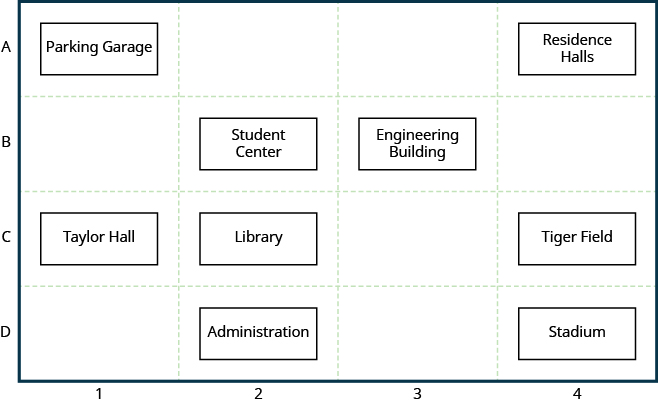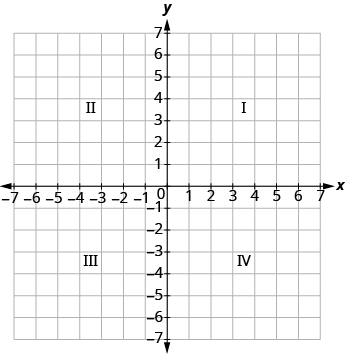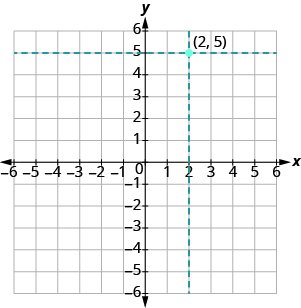Plotting Points on the Rectangular Coordinate System
Learning Outcomes
- Locate an object on a map using coordinate directions
- Plot points on a rectangular coordinate system
- Identify the quadrant where a point is located on a rectangular coordinate system
Many maps, such as the Campus Map shown below, use a grid system to identify locations. Do you see the numbers [latex]1,2,3[/latex], and [latex]4[/latex] across the top and bottom of the map and the letters A, B, C, and D along the sides? Every location on the map can be identified by a number and a letter. For example, the Student Center is in section 2B. It is located in the grid section above the number [latex]2[/latex] and next to the letter B. In which grid section is the Stadium? The Stadium is in section 4D.

example
Use the map above.- Find the grid section of the Residence Halls.
- What is located in grid section 4C?
- Read the number below the Residence Halls, [latex]4[/latex], and the letter to the side, A. So the Residence Halls are in grid section 4A.
- Find [latex]4[/latex] across the bottom of the map and C along the side. Look below the [latex]4[/latex] and next to the C. Tiger Field is in grid section 4C.
try it
[ohm_question]146887[/ohm_question] [ohm_question]146888[/ohm_question] Now, make a vertical number line passing through the [latex]x\text{-axis}[/latex] at [latex]0[/latex]. Put the positive numbers above [latex]0[/latex] and the negative numbers below [latex]0[/latex]. See the image below. This vertical line is called the y-axis.
Vertical grid lines pass through the integers marked on the [latex]x\text{-axis}[/latex]. Horizontal grid lines pass through the integers marked on the [latex]y\text{-axis}[/latex]. The resulting grid is the rectangular coordinate system.
The rectangular coordinate system is also called the [latex]x\text{-}y[/latex] plane, the coordinate plane, or the Cartesian coordinate system (since it was developed by a mathematician named René Descartes.)
Now, make a vertical number line passing through the [latex]x\text{-axis}[/latex] at [latex]0[/latex]. Put the positive numbers above [latex]0[/latex] and the negative numbers below [latex]0[/latex]. See the image below. This vertical line is called the y-axis.
Vertical grid lines pass through the integers marked on the [latex]x\text{-axis}[/latex]. Horizontal grid lines pass through the integers marked on the [latex]y\text{-axis}[/latex]. The resulting grid is the rectangular coordinate system.
The rectangular coordinate system is also called the [latex]x\text{-}y[/latex] plane, the coordinate plane, or the Cartesian coordinate system (since it was developed by a mathematician named René Descartes.)
The rectangular coordinate system

The four quadrants of the rectangular coordinate system

Ordered Pair
An ordered pair, [latex]\left(x,y\right)[/latex] gives the coordinates of a point in a rectangular coordinate system. [latex-display]\begin{array}{c}\text{The first number is the }x\text{-coordinate}.\hfill \\ \text{The second number is the }y\text{-coordinate}.\hfill \end{array}[/latex-display]
 Now we locate the [latex]y[/latex] value, [latex]5[/latex], on the [latex]y[/latex] -axis and sketch a horizontal line through [latex]y=5[/latex] . The point where these two lines meet is the point with coordinates [latex]\left(2,5\right)[/latex]. We plot the point there, as shown in the image below.
Now we locate the [latex]y[/latex] value, [latex]5[/latex], on the [latex]y[/latex] -axis and sketch a horizontal line through [latex]y=5[/latex] . The point where these two lines meet is the point with coordinates [latex]\left(2,5\right)[/latex]. We plot the point there, as shown in the image below.

example
Plot [latex]\left(1,3\right)[/latex] and [latex]\left(3,1\right)[/latex] in the same rectangular coordinate system.Answer:
Solution
The coordinate values are the same for both points, but the [latex]x[/latex] and [latex]y[/latex] values are reversed. Let’s begin with point [latex]\left(1,3\right)[/latex]. The [latex]x\text{-coordinate}[/latex] is [latex]1[/latex] so find [latex]1[/latex] on the [latex]x\text{-axis}[/latex] and sketch a vertical line through [latex]x=1[/latex]. The [latex]y\text{-coordinate}[/latex] is [latex]3[/latex] so we find [latex]3[/latex] on the [latex]y\text{-axis}[/latex] and sketch a horizontal line through [latex]y=3[/latex]. Where the two lines meet, we plot the point [latex]\left(1,3\right)[/latex].
 To plot the point [latex]\left(3,1\right)[/latex], we start by locating [latex]3[/latex] on the [latex]x\text{-axis}[/latex] and sketch a vertical line through [latex]x=3[/latex]. Then we find [latex]1[/latex] on the [latex]y\text{-axis}[/latex] and sketch a horizontal line through [latex]y=1[/latex]. Where the two lines meet, we plot the point [latex]\left(3,1\right)[/latex].
To plot the point [latex]\left(3,1\right)[/latex], we start by locating [latex]3[/latex] on the [latex]x\text{-axis}[/latex] and sketch a vertical line through [latex]x=3[/latex]. Then we find [latex]1[/latex] on the [latex]y\text{-axis}[/latex] and sketch a horizontal line through [latex]y=1[/latex]. Where the two lines meet, we plot the point [latex]\left(3,1\right)[/latex].
 Notice that the order of the coordinates does matter, so, [latex]\left(1,3\right)[/latex] is not the same point as [latex]\left(3,1\right)[/latex].
Notice that the order of the coordinates does matter, so, [latex]\left(1,3\right)[/latex] is not the same point as [latex]\left(3,1\right)[/latex].
try it
[ohm_question]146882[/ohm_question]Exercises
Plot each point in the rectangular coordinate system and identify the quadrant in which the point is located: 1. [latex]\left(-1,3\right)[/latex] 2. [latex]\left(-3,-4\right)[/latex] 3. [latex]\left(2,-3\right)[/latex] 4. [latex]\left(3,\frac{5}{2}\right)[/latex]Answer:
Solution
The first number of the coordinate pair is the [latex]x\text{-coordinate}[/latex], and the second number is the [latex]y\text{-coordinate}[/latex].
1. Since [latex]x=-1,y=3[/latex], the point [latex]\left(-1,3\right)[/latex] is in Quadrant II.
2. Since [latex]x=-3,y=-4[/latex], the point [latex]\left(-3,-4\right)[/latex] is in Quadrant III.
3. Since [latex]x=2,y=-1[/latex], the point [latex]\left(2,-1\right)[/latex] is in Quadrant lV.
4. Since [latex]x=3,y=\frac{5}{2}[/latex], the point [latex]\left(3,\frac{5}{2}\right)[/latex] is in Quadrant I. It may be helpful to write [latex]\frac{5}{2}[/latex] as the mixed number, [latex]2\frac{1}{2}[/latex], or decimal, [latex]2.5[/latex]. Then we know that the point is halfway between [latex]2[/latex] and [latex]3[/latex] on the [latex]y\text{-axis}[/latex].

try it
[ohm_question]146883[/ohm_question]example
How do the signs affect the location of the points? Plot each point: 1. [latex]\left(-5,2\right)[/latex] 2. [latex]\left(-5,-2\right)[/latex] 3. [latex]\left(5,2\right)[/latex] 4. [latex]\left(5,-2\right)[/latex]Answer:
Solution
As we locate the [latex]x\text{-coordinate}[/latex] and the [latex]y\text{-coordinate}[/latex], we must be careful with the signs.

try it
[ohm_question]146885[/ohm_question] We can summarize sign patterns of the quadrants as follows. Also see the graph below.
We can summarize sign patterns of the quadrants as follows. Also see the graph below.
| Quadrant I | Quadrant II | Quadrant III | Quadrant IV |
|---|---|---|---|
| (x,y) | (x,y) | (x,y) | (x,y) |
| (+,+) | (−,+) | (−,−) | (+,−) |
 What if one coordinate is zero? Where is the point [latex]\left(0,4\right)[/latex] located? Where is the point [latex]\left(-2,0\right)[/latex] located? The point [latex]\left(0,4\right)[/latex] is on the y-axis and the point [latex]\left(-2,0\right)[/latex] is on the x-axis.
What if one coordinate is zero? Where is the point [latex]\left(0,4\right)[/latex] located? Where is the point [latex]\left(-2,0\right)[/latex] located? The point [latex]\left(0,4\right)[/latex] is on the y-axis and the point [latex]\left(-2,0\right)[/latex] is on the x-axis.
Points on the Axes
Points with a [latex]y\text{-coordinate}[/latex] equal to [latex]0[/latex] are on the [latex]x\text{-axis}[/latex], and have coordinates [latex]\left(a,0\right)[/latex]. Points with an [latex]x\text{-coordinate}[/latex] equal to [latex]0[/latex] are on the [latex]y\text{-axis}[/latex], and have coordinates [latex]\left(0,b\right)[/latex].The Origin
The point [latex]\left(0,0\right)[/latex] is called the origin. It is the point where the x-axis and y-axis intersect.ExAMPLE
Plot each point on a coordinate grid: 1. [latex]\left(0,5\right)[/latex] 2. [latex]\left(4,0\right)[/latex] 3. [latex]\left(-3,0\right)[/latex] 4. [latex]\left(0,0\right)[/latex] 5. [latex]\left(0,-1\right)[/latex]Answer: Solution
- Since [latex]x=0[/latex], the point whose coordinates are [latex]\left(0,5\right)[/latex] is on the [latex]y\text{-axis}[/latex].
- Since [latex]y=0[/latex], the point whose coordinates are [latex]\left(4,0\right)[/latex] is on the [latex]x\text{-axis}[/latex].
- Since [latex]y=0[/latex], the point whose coordinates are [latex]\left(-3,0\right)[/latex] is on the [latex]x\text{-axis}[/latex].
- Since [latex]x=0[/latex] and [latex]y=0[/latex], the point whose coordinates are [latex]\left(0,0\right)[/latex] is the origin.
- Since [latex]x=0[/latex], the point whose coordinates are [latex]\left(0,-1\right)[/latex] is on the [latex]y\text{-axis}[/latex].

TRY IT
[ohm_question]146886[/ohm_question]Licenses & Attributions
CC licensed content, Original
- Question ID 146885, 146886, 146882, 146883. Authored by: Lumen Learning. License: CC BY: Attribution.
CC licensed content, Specific attribution
- Prealgebra. Provided by: OpenStax License: CC BY: Attribution. License terms: Download for free at http://cnx.org/contents/[email protected].
